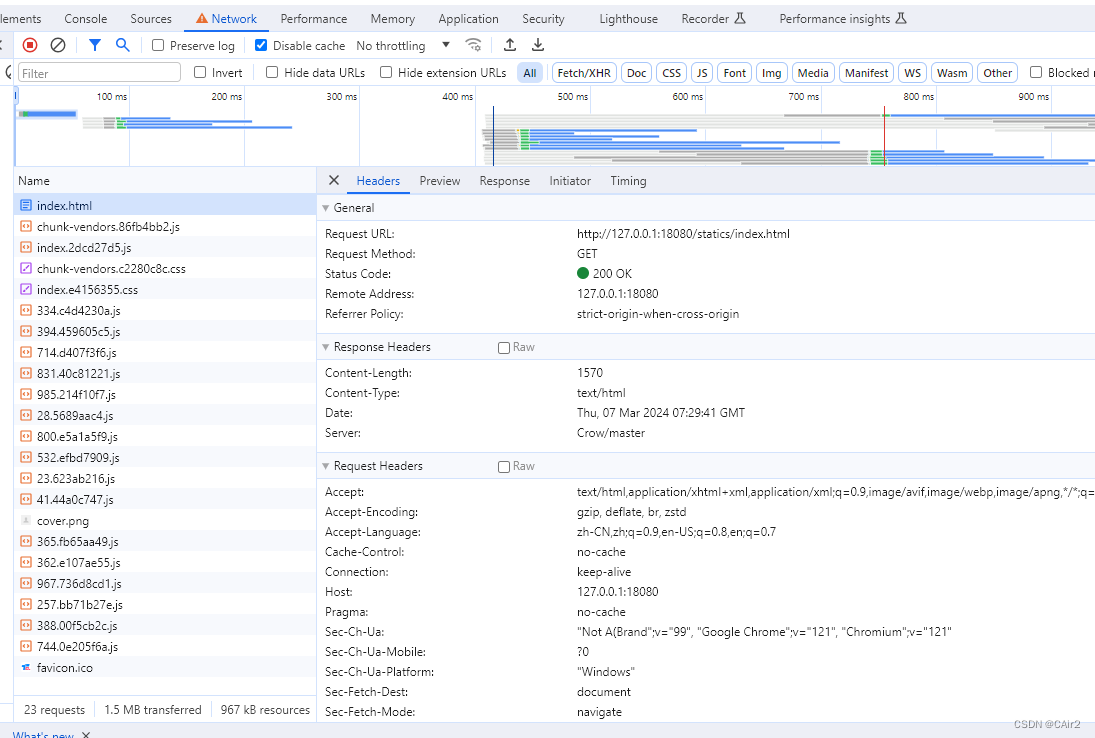crow专题
Crow+opencv+websocket实现实时rtsp视频拉取以及显示
需求:需要将rtsp视频流放到openharmony界面显示 方案一:使用openharmonyAPP中集成ffmpeg(后续更新) 方案二:使用openharmonyAPP中集成opencv(实际原理和方案一一致,因为opencv中集成了ffmpeg,后续更新) 方案三:将视频在服务端拉取,转base64之后使用websocket发送到前端,在openharmonyAPP中使用一个嵌套的W
A - Memory and Crow CodeForces - 712A(水题)
Input The first line of the input contains a single integer n (2 ≤ n ≤ 100 000) — the number of integers written in the row. The next line contains n, the i’th of which is ai ( - 109 ≤ ai ≤ 109) — th
Crow 编译和环境搭建
Crow与其说是编译,倒不如说是环境搭建。Crow只需要包含头文件,所以不用编译生成lib。 Crow环境搭建 boost(可以不编译boost,只需要boost头文件即可)asio (可以不编译,直接包含头文件。不能直接使用boost的asio,boost的asio存在命名空间)zlib (可选)用于web压缩,如果不使用压缩,可以不包含。开启需要定义宏:CROW_ENABLE_COMPRE
Crow:通过表单格式upload文件
除了下载,web后台一个常用的功能便是上传文件,而上传文件通常都是通过表单完成的。 通过表单上传文件时,http 请求头里会有如下信息: Content-Type:multipart/form-data 表示这是一个表单请求 boundary=---------------------------131943921939171068143514392405表示表单数据在body里的分界线
Crow:设置网站的index.html
对于一个网展来说,index.html是其第一个页面,也是根页面,如何通过Crow来加载index.html呢。 Crow:静态资源使用举例-CSDN博客 讲述了静态资源的使用,也就是通常存饭html,css,jpg文件的地方 当然index.html也会放在这个目录,但通常是放在static的根目录,其他资源会根据资源类型放在子目录中 比如可以通过如下方式放置文件 $ tree st
Crow:蓝图路由1 CROW_BP_ROUTE
蓝图路由简单点说可以认为先给路由设置一个根目录,然后在该根目录下设置子路由,比如: 设置蓝图路由为/user/,然后添加子路由add, delete,那么总的路由相当于: /user/add和/user/delete 看一下Crow的实现: #define CROW_ROUTE(app, url) app.template route<crow::black_magic::get_para
Crow:路由局部插件3 调用after_handle
紧接Crow:路由局部插件2 调用before_handle-CSDN博客 完成middleware_call_helper的调用后 把res.complete_request_handler设置为后续处理完handle后将要处理的lambda 然后调用rule->handle,之后返回到Connect::handle,参考 Crow:http请求到Rule绑定的handler_的调用链-CSD
Crow:路由局部插件2 调用before_handle
Crow:http请求到Rule绑定的handler_的调用链-CSDN博客 中介绍了当找到对应的路由后Router::handle template<typename App>typename std::enable_if<std::tuple_size<typename App::mw_container_t>::value != 0, void>::typehandle_rule
Crow: logging的设计
Crow设计了一套简易并且实用的log系统。 想要输出log的地方只需通过如下语句,就能实现混合输出: CROW_LOG_DEBUG << " - MESSAGE: " << message; 看一下CROW_LOG_XXX的定义: #define CROW_LOG_CRITICAL \if
Crow:接受http连接请求do_accept
Crow:run的流程2 建立io_service及线程-CSDN博客 介绍了run的Crow会启动一个线程并用于处理do_accept。 那么do_accept本身是做什么的呢? void Server::do_accept(){if (!shutting_down_){uint16_t service_idx = pick_io_service_idx();asio::io_se
Crow:Middlewares 庖丁解牛5 context
Crow:Middlewares 庖丁解牛4 partial_context-CSDN博客 基于partial_context再来解释context namespace detail{template<typename... Middlewares>struct partial_context : public pop_back<Middlewares...>::template re
Crow:Middlewares 庖丁解牛5 context
Crow:Middlewares 庖丁解牛4 partial_context-CSDN博客 基于partial_context再来解释context namespace detail{template<typename... Middlewares>struct partial_context : public pop_back<Middlewares...>::template re
Crow:http请求到Rule绑定的handler_的调用链
Crow:基于req.rul查找路由Rule对象及匹配参数-CSDN博客 介绍了当接收到http请求后如何查找到Rule对象 Connection::do_read -> HTTPParser::feed ->而feed实际上会依此调用定义于http_parser_settings中的所有函数,并完成http信息的解析const static http_parser_settings
Crow:Middlewares 庖丁解牛3 pop_back
紧随着产生序列 Crow:Middlewares 庖丁解牛2 产生序列-CSDN博客 的代码是pop_back: template<typename Seq, typename Tuple>struct pop_back_helper;template<unsigned... N, typename Tuple>struct pop_back_helper<seq<N...>, T
Crow:基于req.rul查找路由Rule对象及匹配参数
Crow::run()会调用Crow::validate(),而后者会调用router_.validate(); void validate(){//Take all the routes from the registered blueprints and add them to `all_rules_` to be processed.detail::middleware_indices
Crow:Middlewares 庖丁解牛2 产生序列
include\crow\utility.h内有这样一段比较晦涩难懂的代码: template<class T>using Invoke = typename T::type;template<unsigned...>struct seq{using type = seq;};template<class S1, class S2>struct concat;template<unsi
Crow:基于req.rul查找路由Rule对象及匹配参数
Crow::run()会调用Crow::validate(),而后者会调用router_.validate(); void validate(){//Take all the routes from the registered blueprints and add them to `all_rules_` to be processed.detail::middleware_indices
Crow:黑魔法new_rule_tagged实现模板参数的绑定
Crow添加路由的定义: #define CROW_ROUTE(app, url) app.template route<crow::black_magic::get_parameter_tag(url)>(url) Crow:黑魔法get_parameter_tag-CSDN博客 介绍了get_parameter_tag的作用 route的定义为: auto route(std:





